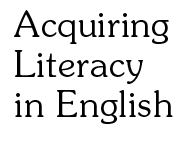Acquiring Literacy in English:
Crosslinguistic, Intralinguistic, and Developmental Factors
Book Task Test
Author and Date
Patton Tabors and Mariela Páez, formerly of the Harvard Graduate School of Education, and Center for Applied Linguistics. 2002.
Purpose
The Book Task Test was designed to investigate young children’s concepts about print, listening comprehension, story retelling ability, and decoding skills. Both the English and the Spanish version of the test were developed for the research study Early Childhood Study of Language and Literacy Development of Spanish-speaking Children, subproject 1 of Acquiring Literacy in English: Crosslinguistic, Intralinguistic, and Developmental Factors.
Age or Grade of Examinees
The assessments were developed to be used with students in pre-school and kindergarten.
Description
The Book Task Test consists of 16 questions that the researcher asks the child as the researcher reads a book to the child. The researcher reads The Carrot Seed (Ruth Krauss; originally published 1945) for the English version, and the Spanish translation La semilla de zanahoria for the Spanish version. The questions require either a verbal answer or an action from the child. For example, on the English test the first question is “Where’s the front of the book?” Question 8 says, “This says ‘A little boy planted a carrot seed.’ Show me where those words are on this page.” Question 14 asks, “What does the boy have in his wheelbarrow?” Question 15 asks the child to retell the story in his own words, and Question 16 is a paraphrase of Question 15.
Administration
The test is individually administered by a trained researcher who is a native speaker of the test language. The assessment takes approximately 15 minutes to administer. The questions are spread over four sections. Section I has seven questions. If the child answers three or more of those questions correctly, then Section II is administered; otherwise the test stops at the end of Section I. Section II also has seven questions; if the child answers four or more questions correctly, Section III is administered. Sections III and IV have one question each (the two story-retelling questions). If the child repeats the text either partially or substantially in answer to the question in Section III, then Section IV is administered.
Scoring and Interpretation
The test is scored dichotomously, “1” for a correct response and “0” for an incorrect response. It can also be scored using Partial Credit (Incorrect, Attempt at Correct Answer, Correct).
Reliability and Validity
For the English version, Rasch analysis (N=330 four year olds) conducted by CAL researchers using dichotomous scoring (with 0=Incorrect and 1=Correct) yielded a reliability coefficient of .66 for the full test.
Validation data are pending.
References
Krauss, R. (1996). La semilla de zanahoria. New York: Scholastic.
Krauss, R. (1945). The carrot seed. New York: HarperCollins.
Sources
The Book Task Test (Spanish and English) was based on research conducted by Snow, Tabors, and others.
Snow, C. E, & Tabors, P. O. (1993). Language skills that relate to literacy development. In Spodek, B. & Saracho, O. (Eds.), Yearbook in Early Childhood Education, 4. New York, NY: Teachers College Press.
Snow, C., Tabors, P., Nicholson, P., & Kurland, B. (1995). SHELL: A method for assessing oral language and early literacy skills in kindergarten and first grade children. Journal of Research in Childhood Education, 10 (1), 37-48.
Availability
The Book Task Test is not available to researchers outside the Center for Applied Linguistics.
Return to the list of researcher-developed assessments.

